Ask a question from expert
Project Management & Information Technology TABLE OF CONTENTS INTRODUCTION
41 Pages6554 Words282 Views
Added on 2020-11-12
About This Document
PROJECT MANAGEMENT & INFORMATION TECHNOLOGY TABLE OF CONTENTS INTRODUCTION 1 STAGE 1 1 Project description and scope1 List of assumptions 3 Planning methodology 3 STAGE 2 9 Project calendar 9 Work breakdown structure (WBS), Organisation breaks down structure (OBS) and responsibility matrix (RAM) 12 Tasks, durations and their logical relationship 15 Execution program 17 Estimation of cost20 Risk register 22 Sub-contractors schedule26 CONCLUSION 26 REFERENCES 28 Illustration table Figure 1: 2018 & 2019 holiday list •
Project Management & Information Technology TABLE OF CONTENTS INTRODUCTION
Added on 2020-11-12
BookmarkShareRelated Documents
PROJECT MANAGEMENT &
INFORMATION TECHNOLOGY
INFORMATION TECHNOLOGY
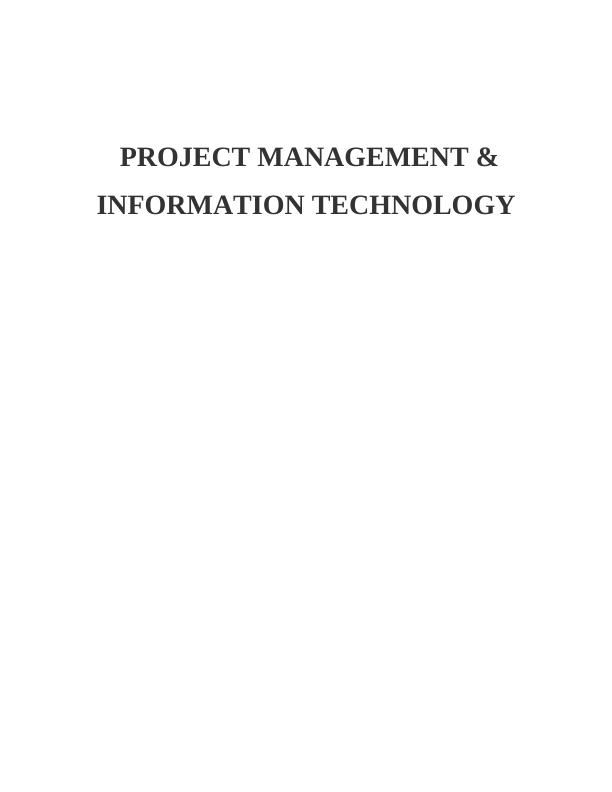
TABLE OF CONTENTS
INTRODUCTION...........................................................................................................................1
STAGE 1.........................................................................................................................................1
Project description and scope......................................................................................................1
List of assumptions......................................................................................................................3
Planning methodology.................................................................................................................3
STAGE 2.........................................................................................................................................9
Project calendar...........................................................................................................................9
Work breakdown structure (WBS), Organisation breaks down structure (OBS) and
responsibility matrix (RAM).....................................................................................................12
Tasks, durations and their logical relationship..........................................................................15
Execution program.....................................................................................................................17
Estimation of cost......................................................................................................................20
Risk register...............................................................................................................................22
Sub-contractors schedule...........................................................................................................26
CONCLUSION..............................................................................................................................26
REFERENCES..............................................................................................................................28
Illustration table
Figure 1: 2018 & 2019 holiday list..................................................................................................9
Figure 2: 2020 holiday list.............................................................................................................10
Figure 3: WBS...............................................................................................................................17
Figure 4: OBS................................................................................................................................18
Figure 5critical path.......................................................................................................................23
Figure 6: Cash flow report.............................................................................................................25
Figure 7: Work Summary..............................................................................................................26
Figure 8: Resource utilisation........................................................................................................27
INTRODUCTION...........................................................................................................................1
STAGE 1.........................................................................................................................................1
Project description and scope......................................................................................................1
List of assumptions......................................................................................................................3
Planning methodology.................................................................................................................3
STAGE 2.........................................................................................................................................9
Project calendar...........................................................................................................................9
Work breakdown structure (WBS), Organisation breaks down structure (OBS) and
responsibility matrix (RAM).....................................................................................................12
Tasks, durations and their logical relationship..........................................................................15
Execution program.....................................................................................................................17
Estimation of cost......................................................................................................................20
Risk register...............................................................................................................................22
Sub-contractors schedule...........................................................................................................26
CONCLUSION..............................................................................................................................26
REFERENCES..............................................................................................................................28
Illustration table
Figure 1: 2018 & 2019 holiday list..................................................................................................9
Figure 2: 2020 holiday list.............................................................................................................10
Figure 3: WBS...............................................................................................................................17
Figure 4: OBS................................................................................................................................18
Figure 5critical path.......................................................................................................................23
Figure 6: Cash flow report.............................................................................................................25
Figure 7: Work Summary..............................................................................................................26
Figure 8: Resource utilisation........................................................................................................27
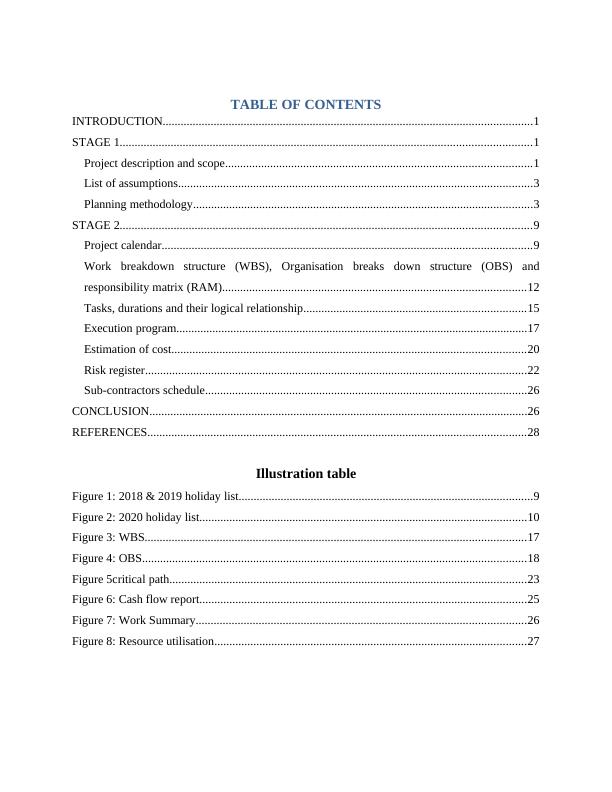
INTRODUCTION
Project management is set of activities that require to accomplish any task successfully.
Execution plan is the document that describes how, when and by whom entire map will be
executed within given timescale. It provides concise summery of whole arrangement, by this
way project manager, (PM) can identify priorities and parameters of a proposal (Marchewka,
2014). Execution plan outlines processes, strategies that are needed to complete the entire
construction project lucratively. Project management tools and techniques support individual in
determining potential risks and finding appropriate solutions to minimise consequences.
Present study is based on the project “development of IT centre” in Canberra, the capital
of Australia. This is a new and unique concept that would develop information technology hub
where all companies and corporate clients will be able to find IT solutions. Assignment will
prepare scope of this task and planning methodology for delivering this project successfully.
Furthermore, it will prepare a work break down structure and Gantt chart. In addition, risk
register will be prepared and manual scheduling will be done to show the completion date of this
IT centre building.
STAGE 1
Project description and scope
Description
Development of new information technology (IT) centre is the big project. For executing
this proposal, client has bought a land on which this IT centre can be build up. Approved budget
for this project is 25 million but owner has allocated 15 million additional funds so that latest
technologies can be used for meeting IT needs for next five years (Kerzner and Kerzner, 2017).
The main objective of sponsor is to construct an IT hub where individual can get all kinds
of solutions related to information technologies. Canberra is the city where this building will be
constructed. There are many others centres already exist but this would be a high tech centre.
In this IT hub there will be all kinds of facilities. Corporate consumers will be able to get
best IT solutions. Team members will get training about latest information technological system
that will help them in providing IT solutions to clients. In the recent era each firm is taking
support of latest technologies so that they can grow well and can reach to mass audience
immediately. These information technology systems support this enterprise in offering excellent
1
Project management is set of activities that require to accomplish any task successfully.
Execution plan is the document that describes how, when and by whom entire map will be
executed within given timescale. It provides concise summery of whole arrangement, by this
way project manager, (PM) can identify priorities and parameters of a proposal (Marchewka,
2014). Execution plan outlines processes, strategies that are needed to complete the entire
construction project lucratively. Project management tools and techniques support individual in
determining potential risks and finding appropriate solutions to minimise consequences.
Present study is based on the project “development of IT centre” in Canberra, the capital
of Australia. This is a new and unique concept that would develop information technology hub
where all companies and corporate clients will be able to find IT solutions. Assignment will
prepare scope of this task and planning methodology for delivering this project successfully.
Furthermore, it will prepare a work break down structure and Gantt chart. In addition, risk
register will be prepared and manual scheduling will be done to show the completion date of this
IT centre building.
STAGE 1
Project description and scope
Description
Development of new information technology (IT) centre is the big project. For executing
this proposal, client has bought a land on which this IT centre can be build up. Approved budget
for this project is 25 million but owner has allocated 15 million additional funds so that latest
technologies can be used for meeting IT needs for next five years (Kerzner and Kerzner, 2017).
The main objective of sponsor is to construct an IT hub where individual can get all kinds
of solutions related to information technologies. Canberra is the city where this building will be
constructed. There are many others centres already exist but this would be a high tech centre.
In this IT hub there will be all kinds of facilities. Corporate consumers will be able to get
best IT solutions. Team members will get training about latest information technological system
that will help them in providing IT solutions to clients. In the recent era each firm is taking
support of latest technologies so that they can grow well and can reach to mass audience
immediately. These information technology systems support this enterprise in offering excellent
1
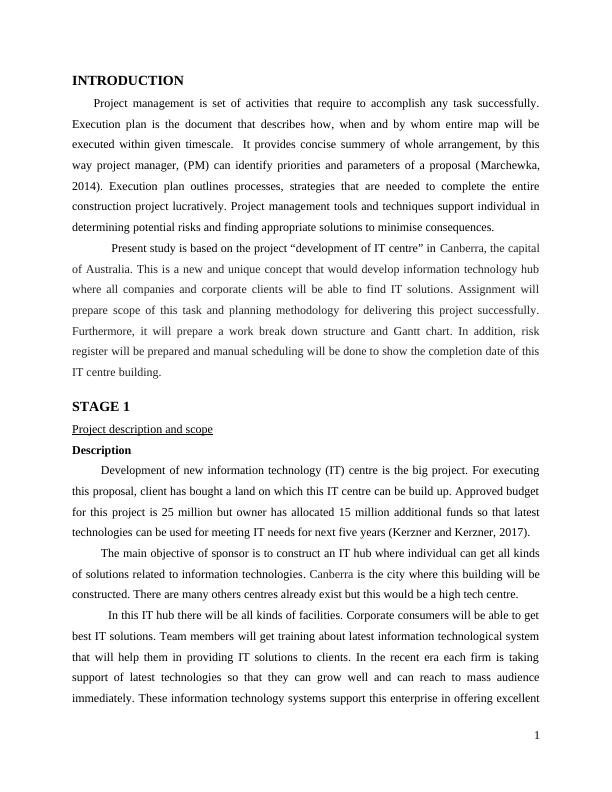
customer services to clients and raising their satisfaction level. In the modern era competition is
too high thus, it has become very important for these entities to offer satisfactory products to
buyers so that they become loyal towards brand.
Objective of project
PM has identified following soft benefits of IT centre project; these are described as
below:
Positive reputation benefit
To finish this development within pre- determined period of time.
Improved quality houses
Customer satisfaction
Minimise and avoid risk and their consequances
Integrated network
Local authority management and raising satisfaction level of stakeholders
Innovation in construction project
Use of advance technologies for resolve IT related issues
Training and development for professionals and engineers.
The major agenda of constructing this IT centre is to increase reputation of company. This
would the first IT hub where clients will be able to get all kinds of IT solutions immediately.
They will not have to wait for longer duration. Company is planning to improve its brand
reputation and this project can support it in achieving its goal. Furthermore, another objective of
business is to improve quality houses and enhance satisfaction level of consumers. There are
many corporate clients those who are unable to get best solution for their technical issue but this
project aims to provide immediate solutions to consumers so that they can feel satisfied.
Development of IT centre task aims to use high tech technologies and equipments so that quality
of plan can be improved. As in this It centre there will be training rooms where all the candidates
will get necessary training related to recent technologies. This will help them in improving their
knowledge and understanding actual benefits of new techniques.
Project scope
IT centre project is completely new and innovative idea. Constructing this building will
give benefits to sponsor in increasing profit to great extent. This would be commercial building
that will meet requirement of all stakeholders (Laudon and Laudon, 2016). This would get a 5-
2
too high thus, it has become very important for these entities to offer satisfactory products to
buyers so that they become loyal towards brand.
Objective of project
PM has identified following soft benefits of IT centre project; these are described as
below:
Positive reputation benefit
To finish this development within pre- determined period of time.
Improved quality houses
Customer satisfaction
Minimise and avoid risk and their consequances
Integrated network
Local authority management and raising satisfaction level of stakeholders
Innovation in construction project
Use of advance technologies for resolve IT related issues
Training and development for professionals and engineers.
The major agenda of constructing this IT centre is to increase reputation of company. This
would the first IT hub where clients will be able to get all kinds of IT solutions immediately.
They will not have to wait for longer duration. Company is planning to improve its brand
reputation and this project can support it in achieving its goal. Furthermore, another objective of
business is to improve quality houses and enhance satisfaction level of consumers. There are
many corporate clients those who are unable to get best solution for their technical issue but this
project aims to provide immediate solutions to consumers so that they can feel satisfied.
Development of IT centre task aims to use high tech technologies and equipments so that quality
of plan can be improved. As in this It centre there will be training rooms where all the candidates
will get necessary training related to recent technologies. This will help them in improving their
knowledge and understanding actual benefits of new techniques.
Project scope
IT centre project is completely new and innovative idea. Constructing this building will
give benefits to sponsor in increasing profit to great extent. This would be commercial building
that will meet requirement of all stakeholders (Laudon and Laudon, 2016). This would get a 5-
2
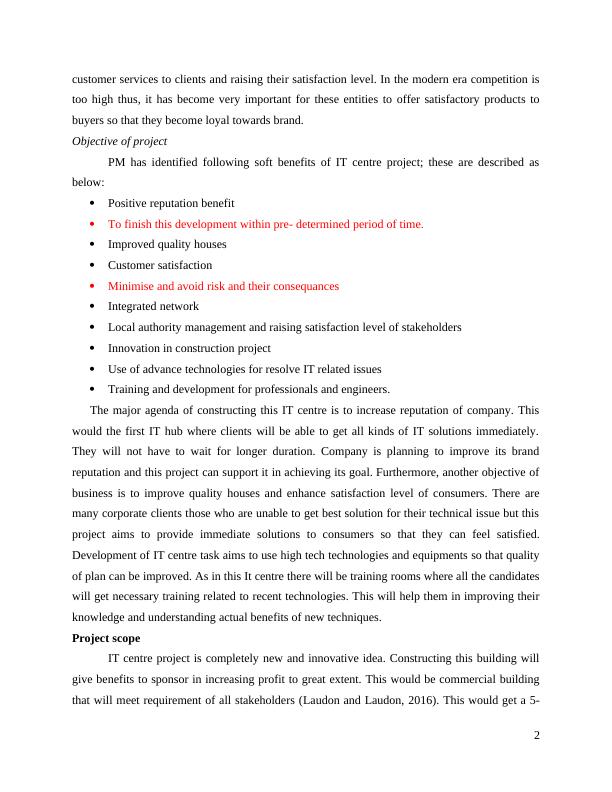
star rating from higher authorities. It will provide training to staff members and will conduct
research and development as well so that long term IT needs can be met. This centre will be
developed as per the global standards. There will be more testing programs, classroom education
for engineers and other IT related professionals.
This Information technology centre will have integrated network facility and fibre
infrastructure. There will be secure remote access for testing hosted equipments. There will be
remote demonstration of storage technologies. All IT focused companies can come here to find
appropriate solutions (Sharp, Peters and Howard, 2017).
List of assumptions
There are some assumptions that are made for executing this IT centre project:
Funding for this construction project will be guaranteed by state government because this
would be an advance high tech IT centre and would contribute in development of state.
Land has adequate space for storing materials
Adequate funds are available for constructing this centre.
Project manager will give necessary training to team members so that they can contribute
well in this development of IT centre project
Sub-contractors will fulfil requirements of execution plan
No additional recruitment will be required in mid of the project as existing people would
be sufficient.
There will be requirement of more than one sub contractor because single subcontractor
will not be able to supervise entire construction.
Existing budget will be appropriate for developing this IT centre.
Overall cost of day-to day activities will remain same as expected
Planning methodology
In order to accomplish the objective of this development of IT centre project, PM will take
support of various methodologies (Lu, P. and et.al., 2015, pp.212-222). Project manager has
selected these methods on the bases of project deliverables, past experiences and by getting
advice from experts. Use of these tools has supported all team members in scheduling activities,
calculating cost and estimating manpower requirements.
Development of IT centre is construction project and for that PM will apply 4 phase
project methodology. All these four stages are helpful in ensuring that completion of project can
3
research and development as well so that long term IT needs can be met. This centre will be
developed as per the global standards. There will be more testing programs, classroom education
for engineers and other IT related professionals.
This Information technology centre will have integrated network facility and fibre
infrastructure. There will be secure remote access for testing hosted equipments. There will be
remote demonstration of storage technologies. All IT focused companies can come here to find
appropriate solutions (Sharp, Peters and Howard, 2017).
List of assumptions
There are some assumptions that are made for executing this IT centre project:
Funding for this construction project will be guaranteed by state government because this
would be an advance high tech IT centre and would contribute in development of state.
Land has adequate space for storing materials
Adequate funds are available for constructing this centre.
Project manager will give necessary training to team members so that they can contribute
well in this development of IT centre project
Sub-contractors will fulfil requirements of execution plan
No additional recruitment will be required in mid of the project as existing people would
be sufficient.
There will be requirement of more than one sub contractor because single subcontractor
will not be able to supervise entire construction.
Existing budget will be appropriate for developing this IT centre.
Overall cost of day-to day activities will remain same as expected
Planning methodology
In order to accomplish the objective of this development of IT centre project, PM will take
support of various methodologies (Lu, P. and et.al., 2015, pp.212-222). Project manager has
selected these methods on the bases of project deliverables, past experiences and by getting
advice from experts. Use of these tools has supported all team members in scheduling activities,
calculating cost and estimating manpower requirements.
Development of IT centre is construction project and for that PM will apply 4 phase
project methodology. All these four stages are helpful in ensuring that completion of project can
3

be on time and with required quality (Miettinen and Paavola, 2014, pp.84-91). 4 phase
methodology is considered as exercise tool that helps in making effective coordination between
various activities so that certain tasks can get completed successfully. It involves: initiation,
design and construct, commission and operational start up, project closure. All these stages are
able to increase stakeholder engagement and accomplishing project within specified period of
time. It is responsibility of PM to conduct this construction project undertaking terms time, cost
and resources (Ding, Zhou and Akinci, 2014, pp.82-93).
Phase 1: Initiation
This is considered as beginning phase in which project manager has to describe overall
task and entails activities. PM first documents the purpose of entire task and frame its objectives.
According to scope, purpose and benefits of higher authorities give approval for certain
proposals. All the team members work together for formally initiating this project (Fitzgerald
and et.al., 2014, pp.1).
The essential activity that needs to be performed by PM of IT centre project is to define
preliminary schedule. Individual is responsible to schedule all activities to find out completion
timing. As development of IT centre is a longer term project thus, it is very important to ensure
that it would be completed within specified period of time (Thompson, 2015). Furthermore,
another most important activity that includes in this initiation phase is estimating cost and risk.
Project manager has to identify the budget that would require to accomplish this objective and
need to find out risk that might cause difficulty in making this project successful.
Next action that includes under this initiation phase is development of project charter. In
this, individual has to describe entire proposal and its benefits for all stakeholders. Manager is
required to plan resources and have to allot all materials in appropriate manner so that overall
needs for involved people can be accomplished (Todorović and et.al., 2015, pp.772-783). As IT
centre development is construction project thus, it is very important for PM to set up their office
so that discussion and meetings can be done at particular place.
Furthermore, this stage includes feasibility study and refining business case. As project
manager of IT centre will identify requirements of all stakeholders and have to refine business
case so that individual meets with expectations of all involved people (Project management
during final execution & commissioning, 2017). Now individual has to create detailed project
plan that involves all activities, their starting and finishing time. This will help in identifying
4
methodology is considered as exercise tool that helps in making effective coordination between
various activities so that certain tasks can get completed successfully. It involves: initiation,
design and construct, commission and operational start up, project closure. All these stages are
able to increase stakeholder engagement and accomplishing project within specified period of
time. It is responsibility of PM to conduct this construction project undertaking terms time, cost
and resources (Ding, Zhou and Akinci, 2014, pp.82-93).
Phase 1: Initiation
This is considered as beginning phase in which project manager has to describe overall
task and entails activities. PM first documents the purpose of entire task and frame its objectives.
According to scope, purpose and benefits of higher authorities give approval for certain
proposals. All the team members work together for formally initiating this project (Fitzgerald
and et.al., 2014, pp.1).
The essential activity that needs to be performed by PM of IT centre project is to define
preliminary schedule. Individual is responsible to schedule all activities to find out completion
timing. As development of IT centre is a longer term project thus, it is very important to ensure
that it would be completed within specified period of time (Thompson, 2015). Furthermore,
another most important activity that includes in this initiation phase is estimating cost and risk.
Project manager has to identify the budget that would require to accomplish this objective and
need to find out risk that might cause difficulty in making this project successful.
Next action that includes under this initiation phase is development of project charter. In
this, individual has to describe entire proposal and its benefits for all stakeholders. Manager is
required to plan resources and have to allot all materials in appropriate manner so that overall
needs for involved people can be accomplished (Todorović and et.al., 2015, pp.772-783). As IT
centre development is construction project thus, it is very important for PM to set up their office
so that discussion and meetings can be done at particular place.
Furthermore, this stage includes feasibility study and refining business case. As project
manager of IT centre will identify requirements of all stakeholders and have to refine business
case so that individual meets with expectations of all involved people (Project management
during final execution & commissioning, 2017). Now individual has to create detailed project
plan that involves all activities, their starting and finishing time. This will help in identifying
4
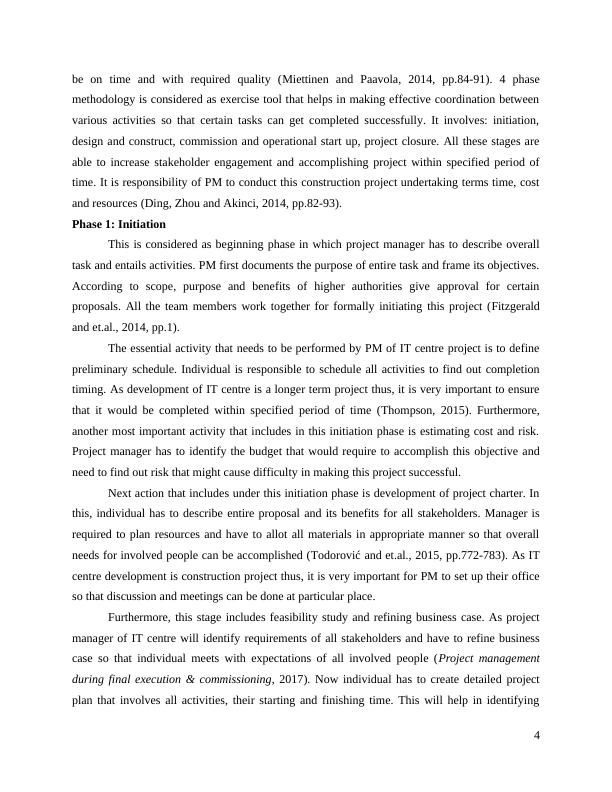
actual completion timing of this task. In addition, PM is responsible for preparing risk register.
In initial phase, project manager must ensure kinds of dangers exist in this scheme and
probability of occurring these issues. Once these risks have been identified then individual can
find out their impact on overall IT centre project. This is the way that would help the person in
preparing contingency plan for mitigating these dangers. This phase will give outline of quality,
risk plans (Marchewka, 2014).
Phase 2: Design and construct
Once planning has been done then individual has to execute entire plan properly. This is
actual implementation of planning and construction of IT centre will begin.
Designing is the first part of this stage in which PM has to prepare organisational model
and governance structure so that prior approval can be taken. Organisational models support in
making authority aware with benefits and scope of this project so that they can give approval for
constructing this IT hub (Kerzner and Kerzner, 2017). Furthermore, designs need to be prepared
for entire building and construction specification need to be highlighted. This will support in
ensuring whether it will be able to satisfy needs of consumers or not. Project manager takes
charge of entire work and supervise working of all involved persons. Individual gives review of
their performance and make changes in plan accordingly so that overall goal can be
accomplished.
Furthermore, procurement, pre-commissioning of IT centre activities take place.PM has
to order raw material and have to contact with suppliers. Engineers are being hired those who
can construct this IT centre properly with required quality. Other activities that include in this
design and construct phase are such as facility planning, recruitment support, operational
planning, training plan development etc (Sharp, Peters and Howard, 2017). PM has to ensure
what kinds of facilities will be available in this IT centre. As it is expected to build advance and
high tech IT centre where all corporate clients will be able to get immediate solution for their
quarries related to information technologies. Thus, manager is required to ensure what kinds of
facilities will be provided thus, its planning is being done in this stage.
Furthermore, individual has to identify requirements of engineers in this project.
According to needs, person has to hire people who can perform well in this construction project.
This activity will help in raising quality of entire project and meeting with global standards
(Ding, Zhou and Akinci, 2014, pp.82-93). In addition, operational planning is being done; in
5
In initial phase, project manager must ensure kinds of dangers exist in this scheme and
probability of occurring these issues. Once these risks have been identified then individual can
find out their impact on overall IT centre project. This is the way that would help the person in
preparing contingency plan for mitigating these dangers. This phase will give outline of quality,
risk plans (Marchewka, 2014).
Phase 2: Design and construct
Once planning has been done then individual has to execute entire plan properly. This is
actual implementation of planning and construction of IT centre will begin.
Designing is the first part of this stage in which PM has to prepare organisational model
and governance structure so that prior approval can be taken. Organisational models support in
making authority aware with benefits and scope of this project so that they can give approval for
constructing this IT hub (Kerzner and Kerzner, 2017). Furthermore, designs need to be prepared
for entire building and construction specification need to be highlighted. This will support in
ensuring whether it will be able to satisfy needs of consumers or not. Project manager takes
charge of entire work and supervise working of all involved persons. Individual gives review of
their performance and make changes in plan accordingly so that overall goal can be
accomplished.
Furthermore, procurement, pre-commissioning of IT centre activities take place.PM has
to order raw material and have to contact with suppliers. Engineers are being hired those who
can construct this IT centre properly with required quality. Other activities that include in this
design and construct phase are such as facility planning, recruitment support, operational
planning, training plan development etc (Sharp, Peters and Howard, 2017). PM has to ensure
what kinds of facilities will be available in this IT centre. As it is expected to build advance and
high tech IT centre where all corporate clients will be able to get immediate solution for their
quarries related to information technologies. Thus, manager is required to ensure what kinds of
facilities will be provided thus, its planning is being done in this stage.
Furthermore, individual has to identify requirements of engineers in this project.
According to needs, person has to hire people who can perform well in this construction project.
This activity will help in raising quality of entire project and meeting with global standards
(Ding, Zhou and Akinci, 2014, pp.82-93). In addition, operational planning is being done; in
5
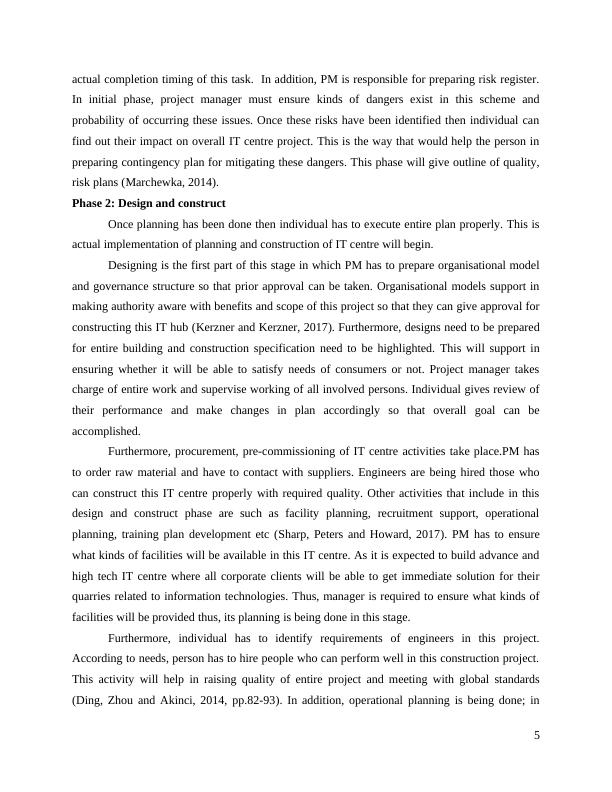
which PM allot responsibilities to all employees as per their capabilities. Their work is
continuously monitored by the supervisor. If PM finds any kind of errors in working efficiency,
then individual give them instructions to correct these mistakes. Training and educational plans
are being prepared so that training can be given to all individual about this IT centre
development projects. Coordination among all employees developed in execution stage so that
people can interact with each other properly and can perform their work without any confusion
(Fitzgerald and et.al., 2014, pp.1).
Phase 3: Commission and operational start up
It is next phase in project execution process; it helps in moving entire project from “end
of construction” to “commercial operation” status. All primary dynamic tests, performance test
are being performed in this stage. It is the period in which control logic is exercised for ensuring
whether place has interlock protection or not (Project management during final execution &
commissioning, 2017). Ramp- up deeds is performed in this stage. PM has to do accreditation
preparation. Furthermore, staff development programs are arranged in this stage so that involved
people can raise their understanding about designing and construction of IT centre. This would
help them in performing well in the future on same projects (Rolfe, Segal and Cicmil, 2016,
pp.48-62).
Phase 4: Closure
This is last stage in which all activities will be finalised and project will be closed. One of
the most essential activities of closure phase is completion of all documentation. Individual has
to ensure that at the end of task all documents get submitted without any error. Furthermore, PM
has to ensure complications related to maintenance and operation. There should not be any kind
of activity that can create trouble in the future (Thompson, 2015). Thus, project manager has to
supervise all tasks and have to confirm its validity. Once all things have been confirmed then it
should be handed over to client. At the end of this stage, project closure report needs to be
submitted to authority so that final confirmation can be received.
Project manager has to ensure whether task is successful or not and it has meet the
requirements of all stakeholders or not. Just that project has been completed does not mean that
managers’ job has been finished (Laudon and Laudon, 2016). Individual has to do many
important things at the end of this phase such as evaluation and preparation of final documents.
6
continuously monitored by the supervisor. If PM finds any kind of errors in working efficiency,
then individual give them instructions to correct these mistakes. Training and educational plans
are being prepared so that training can be given to all individual about this IT centre
development projects. Coordination among all employees developed in execution stage so that
people can interact with each other properly and can perform their work without any confusion
(Fitzgerald and et.al., 2014, pp.1).
Phase 3: Commission and operational start up
It is next phase in project execution process; it helps in moving entire project from “end
of construction” to “commercial operation” status. All primary dynamic tests, performance test
are being performed in this stage. It is the period in which control logic is exercised for ensuring
whether place has interlock protection or not (Project management during final execution &
commissioning, 2017). Ramp- up deeds is performed in this stage. PM has to do accreditation
preparation. Furthermore, staff development programs are arranged in this stage so that involved
people can raise their understanding about designing and construction of IT centre. This would
help them in performing well in the future on same projects (Rolfe, Segal and Cicmil, 2016,
pp.48-62).
Phase 4: Closure
This is last stage in which all activities will be finalised and project will be closed. One of
the most essential activities of closure phase is completion of all documentation. Individual has
to ensure that at the end of task all documents get submitted without any error. Furthermore, PM
has to ensure complications related to maintenance and operation. There should not be any kind
of activity that can create trouble in the future (Thompson, 2015). Thus, project manager has to
supervise all tasks and have to confirm its validity. Once all things have been confirmed then it
should be handed over to client. At the end of this stage, project closure report needs to be
submitted to authority so that final confirmation can be received.
Project manager has to ensure whether task is successful or not and it has meet the
requirements of all stakeholders or not. Just that project has been completed does not mean that
managers’ job has been finished (Laudon and Laudon, 2016). Individual has to do many
important things at the end of this phase such as evaluation and preparation of final documents.
6
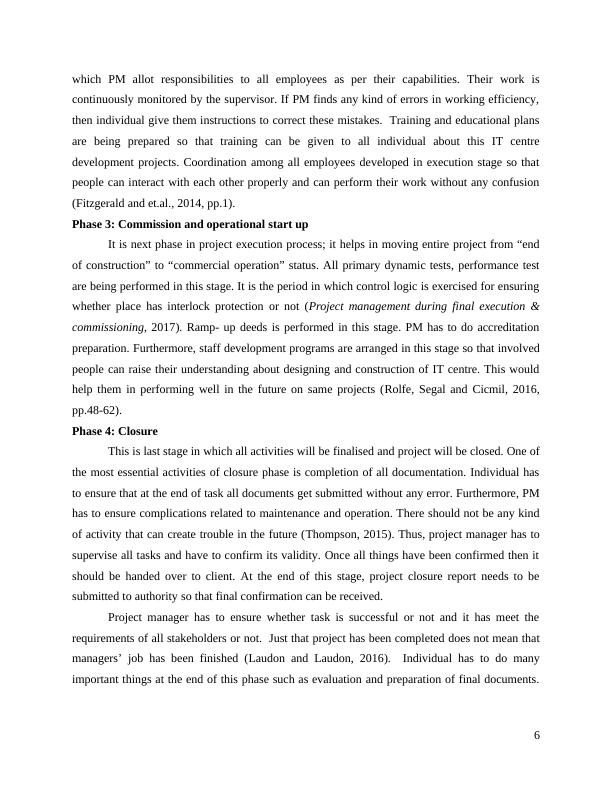
End of preview
Want to access all the pages? Upload your documents or become a member.
Related Documents
Project Plan: Development of IT Centrelg...
|33
|1225
|52
Development of a New Information Technology Centrelg...
|14
|1733
|34
Project Management for Development of Information Technology Centrelg...
|30
|3327
|280
Project Management: WBS, OBS, RAM, Gantt Chart, Risk Registerlg...
|11
|1372
|427
Development of a New Information Technology Centre – Stage 2lg...
|10
|1096
|30
Project Management and Information Technology PDFlg...
|12
|2310
|116